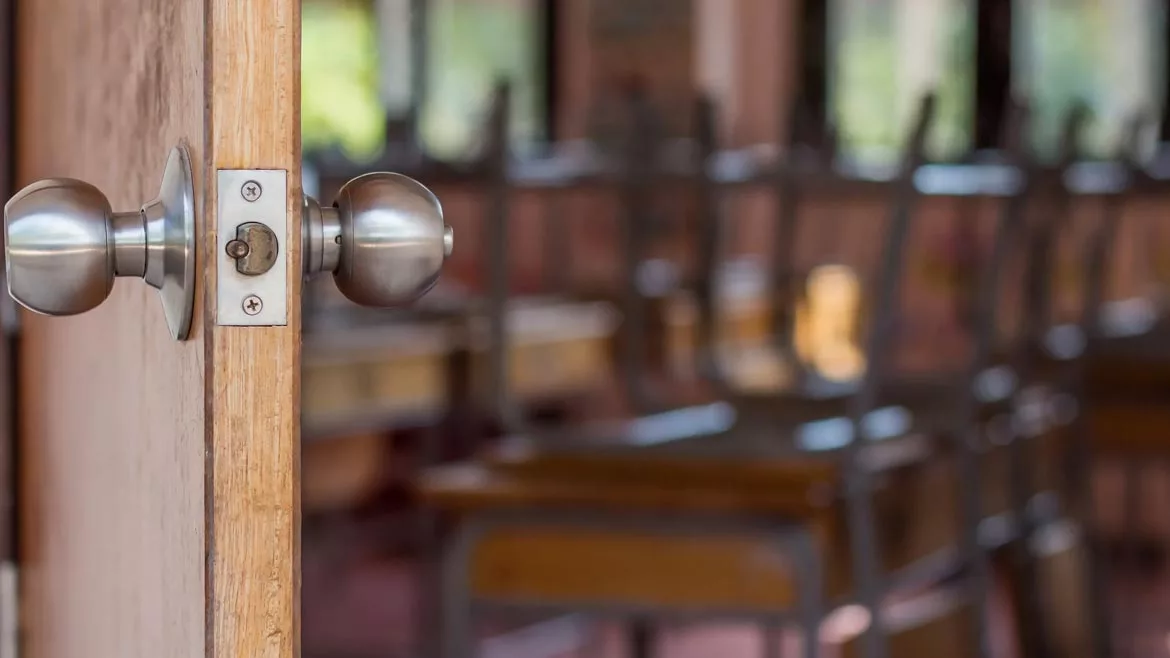Security Talk
School security: A focus on doors

The shooting at Sandy Hook Elementary School in December 2012 in Newtown, Connecticut resulted in the deaths of 20 students and six adults, who were shot and killed by Adam Lanza. Lanza entered the building by shooting through a glass window next to the locked front entrance.
In 2018, Dimitrios Pagourtzis killed 10 students and teachers and wounded 13 others at Santa Fe High School. According to one survivor’s account, the shooter went into two art classrooms and shot through windows on internal classroom doors and closets. In a documentary on the shooting The Kids of Santa Fe: The Largest Unknown Mass Shooting, it was revealed that a back door of one of the art rooms was able to open, and approximately 20 people exited to safety. The other classroom’s back door didn’t open, costing lives in the tragedy because they couldn’t escape.
With all the school security technology available today regarding emergency safety and security scenarios such as active shooter situations, there are a few simple considerations that should not be overlooked by administrators and school security leaders. Perhaps the first and arguably one of the most important considerations is doors.
According to the final report from the Sandy Hook Advisory Commission, there has not been an active school shooter who has breached a locked classroom door to date. Why? Well, it’s really a question of time and opportunity, say school security experts, and locked doors or bullet-proof glass can buy first responders and administrators critical extra minutes to respond and react to a potential emergency situation.
“An active shooter doesn’t have time to screw around with locked doors in the seconds they have. They will go after what they see and what they have the opportunity to go after,” says Guy Grace, former security director at Littleton Public Schools, who responded to his own district’s active shooter situation in 2013, where a student killed another student before shooting himself at Arapahoe High School. Grace is now an active Consultant and Advisor for the Partner Alliance for Safety Schools. “The industry has capitalized on the opportunity with more barricades, cumbersome devices and other technology, but when we think about active shooter scenarios, focusing on locks should be the number one. The best course of action is a properly functioning lock on your classroom doors.”
Cedric Calhoun, CEO of the Door Security and Safety Foundation, says that school stakeholders must take into account the unintended consequences of implementing technologies to prevent active shooters. A few years ago, the foundation started a campaign called Opening the Door to School Safety, which is meant to shine a light on the “importance of locking, not blocking doors.” The main focus, Calhoun says, should be on providing life safety and security to school stakeholders, students and staff in a practical way.
“Barricades or other solutions can be used to prevent the bad guy from getting in, but it can also prevent those locked inside from getting out or from first responders getting in,” Calhoun says. “The key in school crises is to delay the advance of the attacker.”
Indeed, in the aftermath of several school shootings, including Virginia Tech, Platte Canyon High School and West Nickel Mines Amish Schoolhouse, first responders publicly discussed difficulties accessing barricaded classrooms.
For classroom doors with windows on or next to the doors, Grace says that while implementing bullet-proof glass can be helpful, if the door itself is not bullet-proof or the frame is not reinforced, such measures won’t provide the level of deterrence you might expect. “If you are installing brand new doors, then bullet-resistant doors make a lot of sense. But when you are retrofitting, you might be installing reinforced glass, but if the frame and door aren’t reinforced, bullets will get through the doors themselves.”
Grace adds that the path of an active shooter goes back to opportunity. If classrooms have windows, the first, most practical measure is to teach students, staff and administrators to hide from any line of sight in the event of a shooter scenario. Grace points to the Stoneman Douglas High School Shooting in Parkland, Florida, in which Nikolas Cruz killed 17 people and injured 17 others in 2018, walking by classrooms and shooting people he could see from the windows. When it comes to school violence prevention, “It’s not about creating panic. It’s about empowering every single person in that building. In the Stoneman Douglas case, he went door to door. If he didn’t see anyone, he didn’t shoot. If he saw someone there, he shot,” he says. “In those initial seconds, staff and students need to be empowered to seek cover and get out of the line of sight. And when it comes back doors, if they can escape and get out of there, they should have that option too. Once you empower everyone to understand those things, it takes some of the fear away. That’s possibly one of the most powerful and simplest things you can implement.”
Looking for a reprint of this article?
From high-res PDFs to custom plaques, order your copy today!








